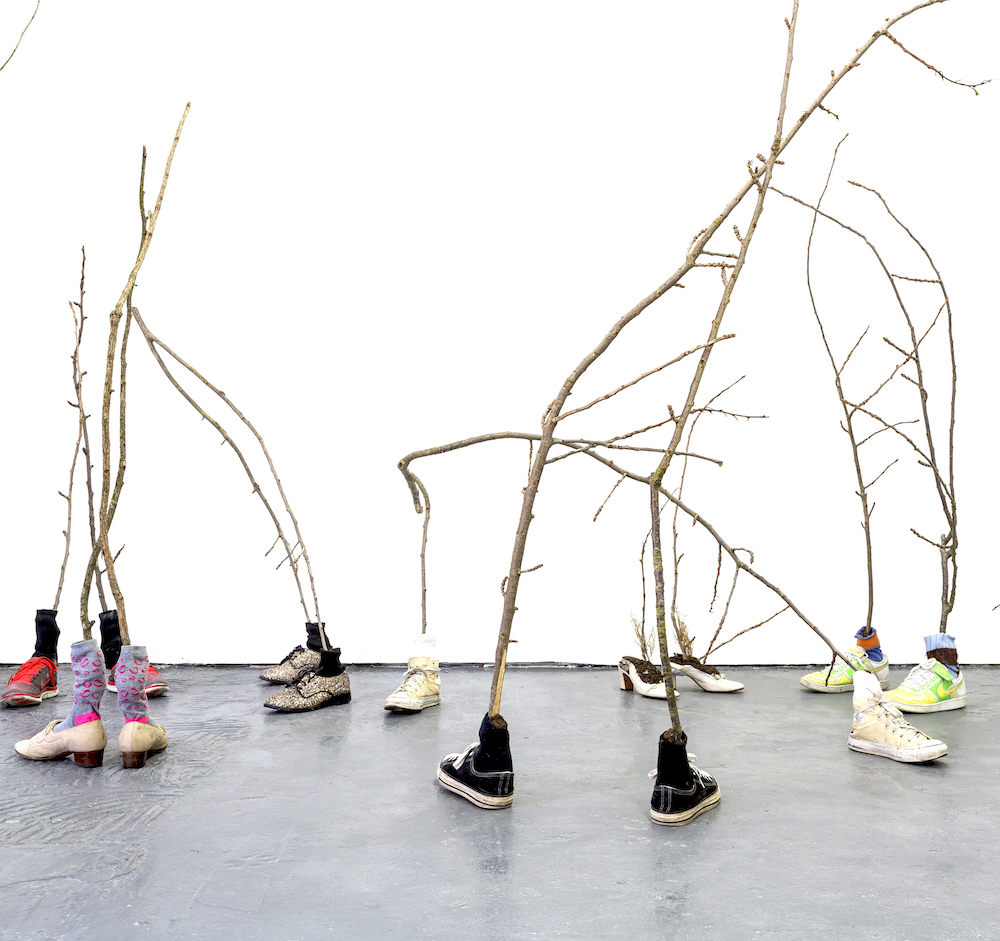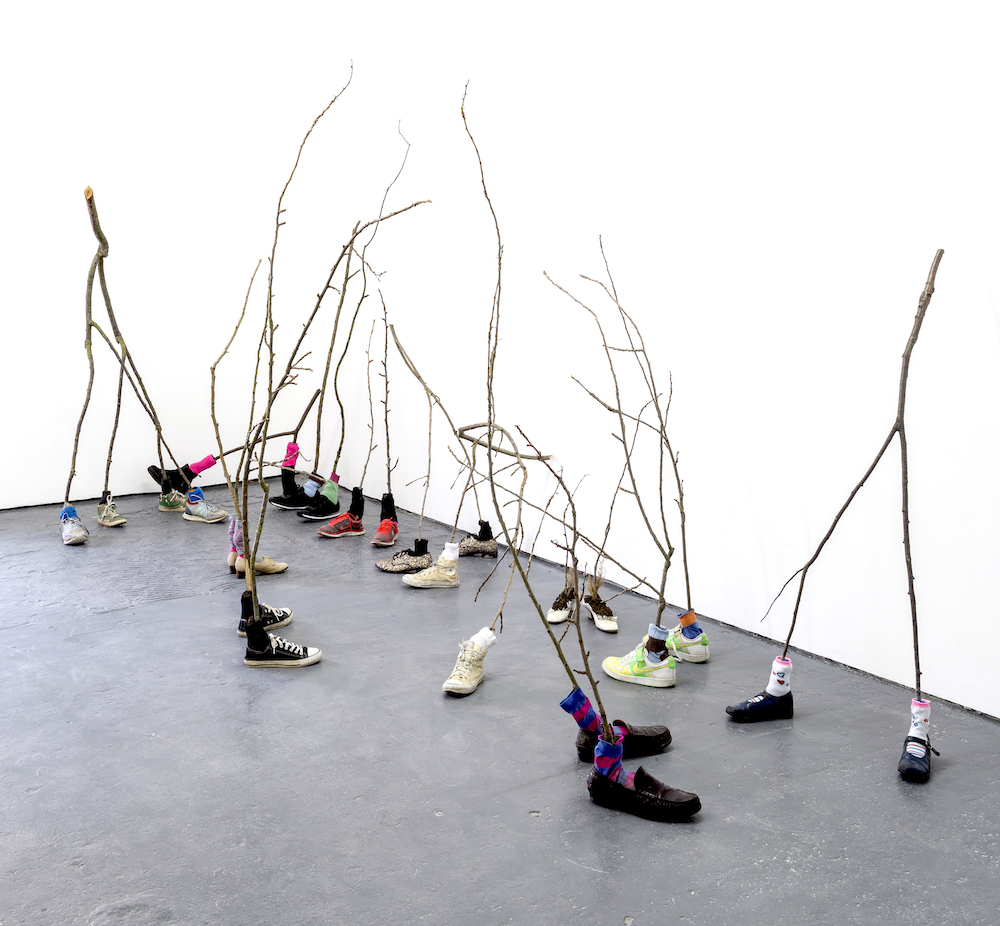
‘Plantón’ is the Spanish word for a sapling, a young tree that is ready to be planted into the ground. It is also the word for a sit-in. This project takes on both: the green to be planted and the peaceful protest. It is about giving the plants and trees the opportunity to ‘walk’ down the streets of a city that is also theirs.
It started in 2010 while I was walking around Lima, my hometown, and noticing how many trees and plants had their leaves blackened with smog, were being treated as trash cans, or even used as bathrooms. I started to put myself in their place and thought I would have left town a long time ago. Instead they are sort of forced to sit there and accept this abuse because of their planted immobile state. I wondered what it would be like to encounter a walking forest that had taken to the streets like any other group of people would do, demanding respect.
Plantón Móvil, however, is not a group of people carrying plants: at least for that time being we are the forest. I find it important to make this distinction because it changes the nature of the gesture. This is about lending our mobility to plants so that they can benefit from the speed and scale that draws people’s attention. In return; we may momentarily borrow some of their slowness.
How has the project developed since you began? Did the first walk go as expected?
The first year, 60 participants showed up with backpacks and shopping carts, riding bicycles and skateboards, pushing wheelbarrows and a wheelchair. It was, even for me, an unexpected success in attendance. The plants were donated and planted in a public park where the mobilization’s route ended. An essential part of this project is that at the end the plants and trees contribute to an existing or new public green area.
Over the years I have seen our participation increase in diversity and number. The following year the event more than tripled with the participation of 200 people. Later on in 2012 I calculated that the attendance peaked at around 400. Since then, the numbers have not increased but other exciting expansions have occurred such as having to organize it from afar in the context of the UN Climate Conference in 2014. It has been taken on and organized by others; once in protest for a group of trees being cut down to build a parking lot. Last year it made its international debut in Providence, Rhode Island and this month we will be forest-walking in Peckham, London at the invitation of the gallery Bosse&Baum and with the support of a Foundation for Contemporary Arts Emergency Grant. I have also started to explore the idea of individual interventions that occur simultaneously in different parts of the world, linking places through shared intention.
Throughout time, this now annual event has drawn support from governmental agencies, NGOs and private companies. Most importantly, it hosts a growing community of people who come from different places and occupations to join around this common interest. The walks never go exactly as expected. I mostly plan and invite the exchange but thanks to the diversity of living and moving forms that the people and plants bring, the experience always unfolds differently. I learn much and honestly have tons of fun too: smoking grandmas loaded up with house plants, people populating the forest with the sounds of monkeys calling and roosters responding, fire trucks shooting water into the air in a show of support, among so many other spontaneous contributions that have boosted, challenged and brought together the walking forests. I work hard in the planning phase but know that ultimately I have to let go and enjoy what unfolds.
Have you noticed that the trees in different cities are treated in different ways, or is our attitude towards them fairly universal?
Plantón Móvil walks against the mistreatment of plants and trees in the city, advocates for the accessibility of public green spaces as a basic right for all and promotes the value of native and adapted plants rather than stressing the conditions of local environments in pursuit of romantic poster-like gardens.
The project started with the urban ‘green’ not only because that was the reality of my immediate environment but also because I felt a need to connect the conversation around climate change with our everyday habits in a more intimate way. Environmental change was (is?) commonly represented by rainforests being cut down, glaciers melting or coral reefs bleaching, typically reinforcing the perception of it happening elsewhere. Conceptually, the effects of it are also complex and come in overwhelming scale. I hoped to encourage a connection that did not feel abstract or foreign.
Essentially, Plantón Móvil is about moving-with as a form of solidarity. It is less about the place and more about the relationship with trees and plants. It’s a particular way of getting to know and relate to our surroundings, hopefully an experience that transcends an eco-trend and roots into our everyday practices. I believe it is a way of starting small and at home that directly points towards the origin of the word ecology: knowledge, study of our home and its relationships. So, by being an attitude it expands the notion of home to wherever we are.
Why do you think we have such fixed, categorized ideas of our fellow living things, and how do you think this could change for the better?
For a while I taught science k-6 while maintaining my art practice, and one of my favorite units was The Characteristics of Living Things. All living things breathe, eat, excrete, grow, reproduce, are sensitive to stimuli from the environment and move. Teaching and re-learning these resonated very much with my work.
I started thinking about how and when movement is used as a measure of livingness: if it does not move then it is most likely dead or sleeping. Perhaps their apparent immobility pushes plants into the category of decorative objects or mere components of a seemingly static landscape. The theatre’s painted backdrop to our and other animals’ daily running. I encounter much less conversation around our relationship to plants as cohabitants or their rights and welfare without any mention to human benefit than I do for other animals. I personally believe that movement plays a crucial role in the distinction.
Most categories establish the dividing line between an inside and an outside, one and the other but perhaps it is the fixation on the borders that becomes problematic. Especially when these are absolute, hierarchical, or externally imposed. However, we do not want to all be the same, diversity is key, there should be space for groupings that are fluid and permeable, curious and appreciative of difference and hence lead us to constantly push what we think we know. Re-encountering the 7 characteristics shared by all living things has made me focus on how to perceive and represent plant movement. How can I/we explore the distances that make us different or similar to ultimately incorporate otherness into the way we observe, move and make contact with our environment?
Do you hope for your work to promote a change in action, attitude, thinking… or perhaps all three?
Yes, I would hope to offer an alternative way of thinking about plants, starting with the ones living with us.
I like to think that people who have participated in Plantón Móvil find themselves walking around their city, run into the plants they walked with and say ‘hi’, or comment to the person walking with them about their experience so it gets shared and retold when they encounter each other in the resulting green spaces.
I cannot control what the individual experience is of those participating, but I believe that putting oneself in someone else’s shoes (in this case roots) is a form of empathy. I hope that is communicated, lasts past the mobilization and inspires a change that starts with paying attention, a consideration that hopefully inspires respect and care. So, although I realize those are big expectations, I do hope that developing a connection with individual trees and plants is a means of cultivating a broader ecological consciousness.
‘Plantón Móvil’ with Lucia Monge: Workshop 23 July, Walk 30 July at Bosse & Baum, Peckham as part of Artificial Arcadia





